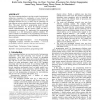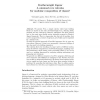71 search results - page 4 / 15 » A theory model core for module interconnection languages |
PLDI
2009
ACM
14 years 2 months ago
2009
ACM
The client computing platform is moving towards a heterogeneous architecture consisting of a combination of cores focused on scalar performance, and a set of throughput-oriented c...
POPL
1990
ACM
13 years 11 months ago
1990
ACM
Typed -calculus is an important tool in programming language research because it provides an extensible framework for studying language features both in isolation and in their rel...
COGSCI
2010
13 years 6 months ago
2010
It is frequently claimed that the human mind is organized in a modular fashion, a hypothesis linked historically, though not inevitably, to the claim that many aspects of the huma...
ECOOP
2009
Springer
14 years 8 months ago
2009
Springer
We present FJig, a simple calculus where basic building blocks are classes in the style of Featherweight Java, declaring elds, methods and one constructor. However, inheritance has...
PEPM
2009
ACM
15 years 7 months ago
2009
ACM
The Verilog hardware description language has padding semantics that allow designers to write descriptions where wires of different bit widths can be interconnected. However, many ...


